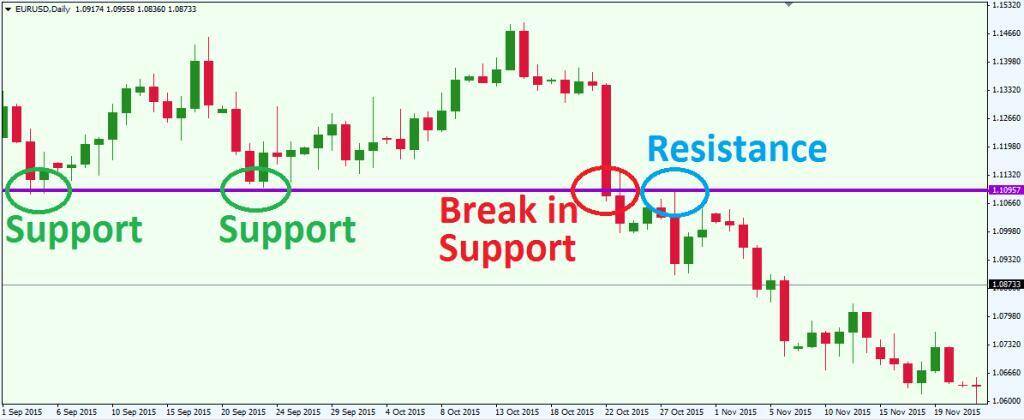
The likelihood of the price rising to the resistance level, consolidating, absorbing all the supply, and declining is high. The resistance is one of the critical technical analysis tools which market participants look at in a rising market. When calculated each day, support, resistance and the daily pivot points do not change on the chart depending on the time period you select, or based on the settings you prefer. They do not adjust to current price, but they remain constant and absolute. They provide one of the surest ways of identifying bullish and bearish conditions for currency pairs and other securities on the given day. Traders would be looking at the third major resistance level as an exit price in the event of an event-driven breakout.
What is the best indicator for support and resistance?
Fibonacci levels are one very popular set of indicators used widely in determining support and resistance. Many traders also make heavy use of moving averages when determining support and resistance level, and pivot points are also quite popular.
The resistance level is a price point on the chart where traders expect maximum supply (in terms of selling) for the stock/index. The resistance level is always above the current market price. The simple method of arithmetic is adopted then, to determine the three levels of support and resistance. Once you have calculated the pivot level, the major resistance levels, these being R1, R2, and R3, can also be calculated. When the market is trending to the upside, resistance levels are formed as the price action slows and starts to move back toward the trendline. When price is moving against the prevailing trend, it is called a reaction.
How to Find and Use Support and Resistance Levels: Best Indicators and Strategies for S&R
Contrary to support, a resistance level is the price point at which an asset is expected to experience significant selling pressure. It’s a zone where a bullish trend is thought to experience temporary resistance or total reversal. When an asset’s price reaches this level, it is often met with many sellers interested in selling it, resulting in a reversal of the uptrend and a subsequent price decline. Several factors can contribute to the establishment of a support level. Support zones are typically found near the previous low prices, while resistance zones are typically found near the previous high prices. Identifying these levels could potentially help determine entry and exit points for trades.
You can use them to identify potential support or resistance areas and make informed trading decisions. Vice versa, foreseeing the resistance level may also be beneficial, as it serves as a price level, which https://traderoom.info/what-is-adx-trend-indicator/ can harm your long position. We can also see the annual long black Pivot line stretching across the screen on the daily chart. The price is mainly below that line, so the market sentiment is rather bearish.
More articles on Technical Analysis
In the example below, using an hourly chart, a day’s pivot and major support levels can be calculated. Some investors dismiss support and resistance levels entirely because they say that the levels are based on past price moves, offering no real information about what will happen in the future. But all of technical analysis is based on using past price action to anticipate future price moves; therefore, this is an argument for dismissing technical analysis entirely. Let’s imagine that Jim notices that the price fails to get above $39 several times over several months, even though it has gotten very close to moving above that level. In this case, traders would call the price level near $39 a level of resistance.
Polygon (MTIC) Price Analysis – 10 June 2023 Market Insights – CryptoGlobe
Polygon (MTIC) Price Analysis – 10 June 2023 Market Insights.
Posted: Sat, 10 Jun 2023 07:14:21 GMT [source]
For example, the Fibonacci retracement is a favorite tool among many short-term traders because it clearly identifies levels of potential support/resistance. On the other hand, when the market is trending to the downside, traders will watch for a series of declining peaks and will attempt to connect these peaks together with a trendline. To be a valid trendline, price needs to touch the trendlines at least three times. Sometimes with stronger trendlines, price will touch the trendline several times over longer time periods.
Trading Ranges
An attempt to cross the key level failed, and the correction will likely continue. Let’s now set the support level and resistance level on the Forex platform. As we see from the chart above, something prevents Bitcoin from growing above a certain price level. On the above chart you can see a good example of a support level at 29,000 USD for one Bitcoin.
What is the indicator that shows support and resistance Tradingview?
The Support Resistance Classification (VR) indicator shows SR levels on any chart's visible range using higher time-frame data (HTF). Levels are classified 1 through 10 based on their strength, with lower values indicating stronger support/resistance levels.
Support and resistance levels are used in technical analysis to predict reversals in price trends. A falling price might be likelier to stop falling when it nears a support level. Conversely, a rising stock price might be likelier to stop increasing when it nears a resistance level. Support and resistance levels are not infallible and, as we will see later, determining such price ranges is no simple task.
Preceding Price Move
The pivot point (PP) is the average of the high, low, and close prices of the previous period, usually a day, a week, or a month. The PP acts as a reference point for the current period, and traders use it to determine the direction and strength of the market trend. If the price is above the PP, the market is considered bullish; if it is below, it is bearish.

Whereas, the resistance is a level on the chart above the current price, where selling pressure exceeded the buying pressure and the price declines. The 3rd major resistance level is generally only broken through as a result a major economic or financial event. These include earnings, central bank and government policy, and other global events. Traders would be looking at the second major resistance level as an entry price in the event of an extended rally. Traders would be looking at the first major support level as an entry price. Support levels refer to price levels below which an asset does not drop for an extended length of time.
Explore the markets with our free course
The chart above is an example of how we can continue the previous candle analysis. The red segments indicate the local lows from the previous analysis. The dotted lines mark the daily TF’s local extremums the way I did on the weekly chart. As a result, we see several things that weren’t obvious when analyzing the weekly chart. Despite the global bullish market wave, the XAUUSD is correcting locally after establishing a new trading range.
- Traders use all methods when looking for support and resistance levels.
- In our case, the ATL hasn’t been updated for more than 20 years, so the asset is highly unlikely to reach that level soon.
- Sell orders increase when the price returns to previous support as traders try to avoid losses.
- The price level is usually depicted in a range and not at a single price point.
- The last part isn’t strictly necessary but will help assess the usefulness of our results.
Serving as one of the key concepts of technical analysis, support and resistance levels form the basis of a wide range of technical analysis tools. Determining the future level of support may help provide traders with an accurate view of the price level that could prop up the asset’s price. These are areas where support and resistance levels are relatively close and price bounces between two levels for a period of time. Experienced traders will sometimes trade within these trading ranges, which are also known as sideways trends. One strategy that they use is to place short trades as the price touches the upper trendline and long trades as price reverses to touch the lower trendline.
Which EMA is best for support and resistance?
Traders can use any moving average that they like, some common lengths are the 9, 21, 50, 100 and 200 period moving averages. Traders might use the 100-period moving average on a daily chart to indicate stronger and longer term levels of support and resistance. Price may only move this far every few months.